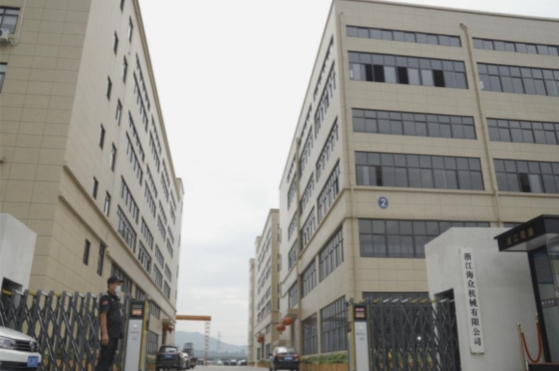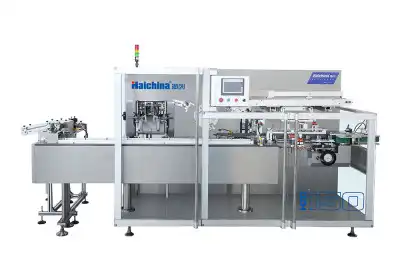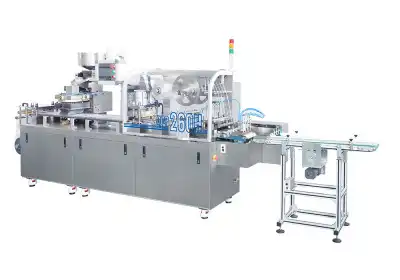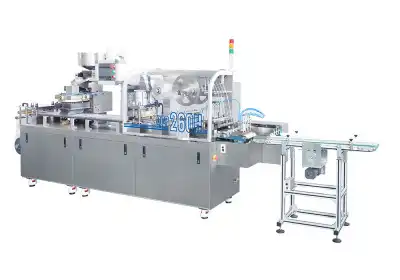How to Maintain a Blister Packaging Machine for Long-Term Efficiency?
Maintaining a blister packaging machine for long-term efficiency is crucial for ensuring consistent production quality and minimizing downtime. Regular maintenance, proper cleaning procedures, and timely component replacements are key to extending the lifespan of your packaging equipment. By implementing a comprehensive maintenance strategy, you can optimize the performance of your blister packaging machine, reduce operational costs, and maintain high-quality packaging standards. This guide will explore essential maintenance practices, troubleshooting techniques, and preventive measures to keep your blister packaging equipment running smoothly for years to come.

Essential Maintenance Practices for Blister Packaging Machines
Daily Cleaning and Inspection Routines
Establishing a daily cleaning and inspection routine is paramount for maintaining the efficiency of your blister packaging machine. Begin each shift by thoroughly cleaning all surfaces, especially those in direct contact with packaging materials. Use appropriate cleaning agents and soft cloths to remove any residue or debris. Inspect sealing plates, forming tools, and conveyor belts for signs of wear or damage. Lubricate moving parts as recommended by the manufacturer to reduce friction and prevent premature wear.
Regular Calibration and Alignment Checks
Proper calibration and alignment are crucial for producing high-quality blister packs. Regularly check and adjust the alignment of sealing plates, forming tools, and cutting mechanisms. Ensure that temperature and pressure settings are accurate and consistent across all stations. Use calibration tools provided by the manufacturer or consult with a technician to perform precise adjustments. Maintaining proper calibration will help minimize defects and improve overall packaging quality.
Preventive Maintenance Schedule
Develop a comprehensive preventive maintenance schedule based on the manufacturer's recommendations and your specific production requirements. This schedule should include tasks such as replacing wear parts, checking electrical connections, and inspecting pneumatic systems. Regularly test safety features and emergency stop mechanisms to ensure they function correctly. By adhering to a preventive maintenance schedule, you can identify potential issues before they lead to costly breakdowns and production delays.
Troubleshooting Common Issues in Blister Packaging Equipment
Sealing Problems and Solutions
Sealing issues are among the most common problems encountered in blister packaging machines. If you notice inconsistent or weak seals, check the temperature and pressure settings of the sealing station. Inspect sealing plates for damage or wear and replace them if necessary. Ensure that the blister material and lidding foil are compatible and of the correct specifications. Adjust dwell time and pressure as needed to achieve optimal sealing results.
Forming Defects and Remedies
Forming defects, such as incomplete or misshapen cavities, can significantly impact packaging quality. Verify that the forming temperature is appropriate for the blister material being used. Inspect forming tools for damage or buildup of debris and clean or replace them as needed. Check the air pressure in the pneumatic system and adjust it to ensure proper cavity formation. If problems persist, consider consulting with the machine manufacturer or a packaging expert for advanced troubleshooting.
Addressing Feed and Ejection Issues
Feed and ejection problems can lead to product waste and reduced efficiency. Ensure that feed mechanisms are clean and properly aligned. Check for any obstructions in the product path and clear them if present. Verify that ejection systems are functioning correctly and adjust timing as necessary. Regularly inspect and maintain conveyor belts, rollers, and guide rails to ensure smooth product flow through the packaging process.
Optimizing Performance and Extending Machine Lifespan
Implementing Operator Training Programs
Well-trained operators are essential for maintaining the efficiency of blister packaging machines. Develop comprehensive training programs that cover proper machine operation, maintenance procedures, and troubleshooting techniques. Encourage operators to report any unusual sounds, vibrations, or performance issues promptly. Regular refresher courses and updates on new features or procedures will help ensure that operators are equipped to handle the equipment effectively and safely.
Utilizing Data Analytics for Predictive Maintenance
Incorporate data analytics and monitoring systems to track machine performance and identify potential issues before they escalate. Use sensors and software to collect data on key parameters such as temperature, pressure, and cycle times. Analyze this data to detect patterns or anomalies that may indicate impending problems. By implementing predictive maintenance strategies, you can schedule interventions at optimal times, minimizing unplanned downtime and maximizing overall equipment effectiveness.
Upgrading Components for Enhanced Efficiency
Stay informed about technological advancements in blister packaging equipment and consider upgrading components to improve efficiency and performance. Newer servo motors, control systems, or forming tools may offer significant benefits in terms of speed, precision, and energy efficiency. Consult with the machine manufacturer or packaging experts to identify potential upgrades that align with your production goals and budget constraints. Investing in modern components can extend the lifespan of your blister packaging machine and keep it competitive in today's fast-paced manufacturing environment.
Conclusion
Maintaining a blister packaging machine for long-term efficiency requires a multifaceted approach that combines regular cleaning, preventive maintenance, and strategic upgrades. By implementing the practices outlined in this guide, you can significantly extend the lifespan of your equipment, reduce operational costs, and ensure consistent packaging quality. Remember that each machine may have unique requirements, so always consult the manufacturer's guidelines and seek expert advice when necessary. With proper care and attention, your blister packaging machine can remain a reliable and efficient asset in your production line for years to come.
FAQs
How often should I perform maintenance on my blister packaging machine?
Regular maintenance should be performed daily, weekly, and monthly, depending on the specific tasks. Daily cleaning and inspections are crucial, while more in-depth maintenance may be scheduled weekly or monthly based on usage and manufacturer recommendations.
What are the signs that my blister packaging machine needs immediate attention?
Signs include inconsistent sealing quality, unusual noises or vibrations, frequent jams or misfeeds, and visible wear on components. If you notice any of these issues, it's important to address them promptly to prevent more serious problems.
Can I perform all maintenance tasks in-house, or should I hire a professional?
While many routine maintenance tasks can be performed in-house by trained operators, it's advisable to have a professional technician perform more complex maintenance and repairs, especially for specialized components or calibration procedures.
Reliable Blister Packaging Machines from Haichina
At Haichina, we are a trusted blister packaging machine supplier, offering high-quality blister packaging machines designed for optimal performance, efficiency, and reliability. Our state-of-the-art equipment is suitable for a wide range of pharmaceutical packaging applications and can be customized to meet your specific production requirements. With over 20 years of industry experience and a dedicated manufacturing facility, Haichina provides innovative solutions that help streamline your packaging operations and ensure consistent product quality. Contact us at [email protected] to learn more about our blister packaging machines and explore the right solution for your business.
References
Johnson, A. (2022). Blister Packaging Machine Maintenance: A Comprehensive Guide. Packaging Technology Today, 18(3), 45-52.
Smith, R. & Brown, T. (2021). Optimizing Blister Packaging Efficiency through Preventive Maintenance. Journal of Pharmaceutical Packaging, 29(2), 112-125.
Wilson, E. (2023). Advanced Troubleshooting Techniques for Blister Packaging Equipment. International Journal of Packaging Research, 41(4), 287-301.
Thompson, L. et al. (2020). The Impact of Operator Training on Blister Packaging Machine Performance. Pharmaceutical Manufacturing, 15(2), 78-90.
Garcia, M. & Lee, S. (2022). Predictive Maintenance Strategies for Pharmaceutical Packaging Equipment. Drug Development and Industrial Pharmacy, 48(6), 723-735.
Anderson, K. (2021). Innovations in Blister Packaging Machine Design: Implications for Maintenance and Efficiency. Packaging Science and Technology, 34(3), 201-215.

Submit the form now to get a unique quote!

ZHEJIANG HAIZHONG MACHINERY CO., LTD.
Popular Blogs
-
 Successful caseProducts and services
Successful caseProducts and servicesHow to Train Employees to Operate a Bottle Packing Machine Effectively?
-
 Successful caseIndustry insights
Successful caseIndustry insightsThe Blister Packaging Process: A Complete Step-by-Step Guide
-
 Successful caseComparative analysisIndustry insights
Successful caseComparative analysisIndustry insightsWhat Type of PVC Is Best for Blister Packing Machines?